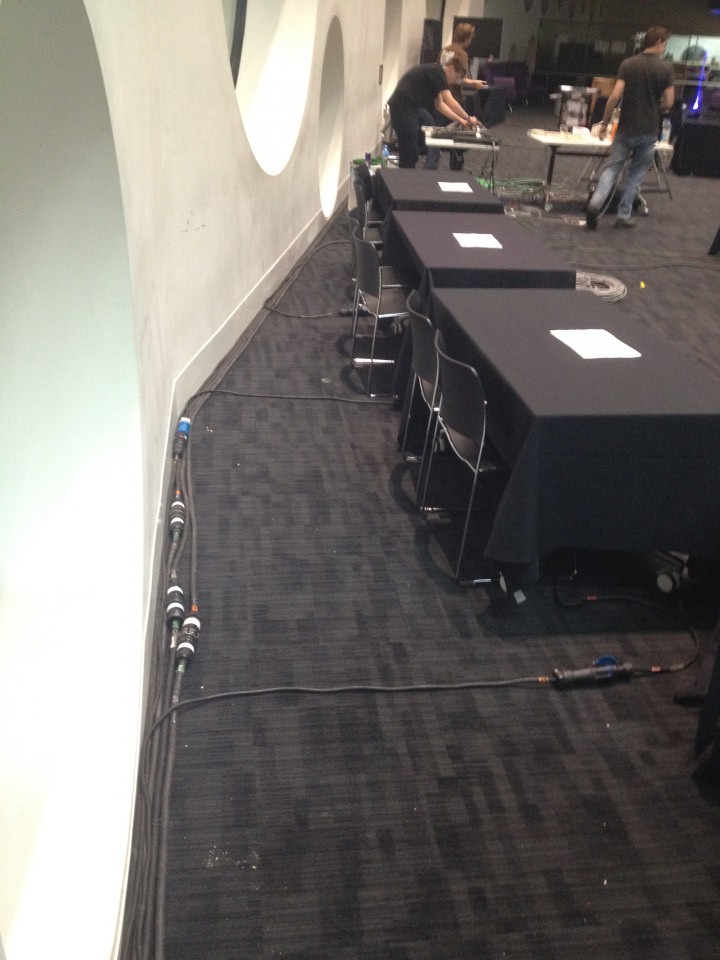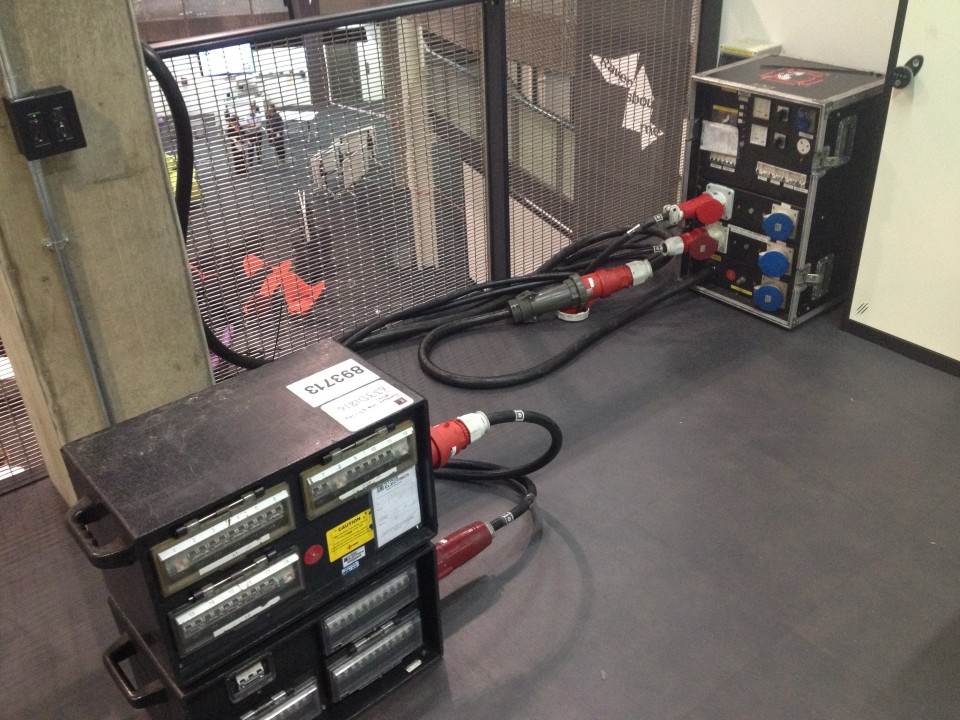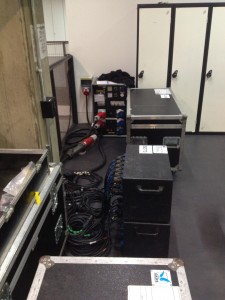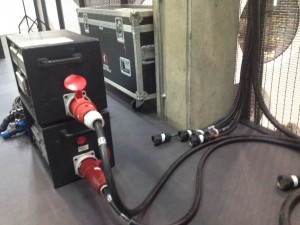Posts tagged socket

SeeIT
Today we are providing power for a small (25 stall) event at Ravensbourne on Level 4. For this event we were asked to provide power for 30 stalls and a few lights, all requiring hot power. Each stall was provided with 2 x 13A socket with enough power to run a couple of TV’s and Laptop’s each up to a maximum of 16amp’s per stall.
The events main supply was from a single 125A 3ph which was then split down to two 63A 3ph supplies, before being split down to individually protected 16amp circuits for each stall. This gave us plenty of protection against overloads as well as surges and faults. The system has fault protection at 3 levels before it tripped out the whole event, each 16A feed has its own RCD, each group of 18, 16A sockets had there own 63A 3ph MCB protection and the whole event had 125A 3ph RCD and MCB protection at supply and in distribution.
The bulk of the event was cabled using 6 way 2.5mm SOCA with Fan in’s and fan outs at each end, this provided an easy rig and de rig with only 6 SOCA’s being run out to the required locations, and only 3m and 5m 16A extensions to provide final distribution from the fan outs.
Each stall could pull up to 16A with out tripping the individual circuit , but if all 25 had pulled the full 16A, they would have tripped out the incoming breakers as the supply is only protected at 125A 3PH, but 25 stalls all at maximum load would pull 133.3A per phase. Due to the fact that most stall’s were only running a laptop and possibly a tv or small projector, this limit will never be reached, even if a few stalls do draw the maximum available.
During the event today we took some current readings on our main distro and each phase was so low it was unreadable on the meter and the meter’s range was from 50A to 200A.
Today also used the exact kit we have specified for the upcoming 3D Storytelling Conference in late March, and provided a useful insight into any problems we may come across when we rig the next event, in the same space.
Photos after the break:
Penrose Market 2011
For Penrose Market I was allocated the job role of head rigger. The tasks that I was to undertake in this role was to come up with a power plan for both the market on the ground floor and on level 4 of Ravensbourne. The reasoning behind doing this, even though there is already plenty of power in the floor boxes, is to make sure that there are enough power sockets for each stall and to give us greater control over the power that is being used on each phase of electricity.
When I was given the original list of the power requirements from Russell I nearly jumped out of my skin, as there was 103 stalls that required power across both the ground and 4th floor. This was going to be the biggest power distribution system I have every designed. To start with I need to work out what power was required on which floor, this meant going through all of the original requirements that Russell had put together and working out where each stall was placed on the floor plans. I worked out that there was 30 stalls on level 4 and 73 on level 0 requiring power. I then looked at the best distribution system for the 2 locations and made the choice to use the 63 Amp 3 phase on level 7 to power level 4 and the 125 Amp 3 phase that is in the OB point out the back of the walker space to power level 0.
My original concept for level 4 was to have a short cable going from the socket to the distro and then use soca to run the distance down the side of the balcony to the stalls on the 4th floor. In the end I decided against this as it was going to massively increase the cost of soca and getting a longer length of 63 amp cable was working out much cheaper. This also meant less mess of cables on the 4th floor and a quicker rig time, as we only had to drop 1 cable over the balcony from level 7 to 4. Level 0 kept to the original design as I had to run at least 10M of 125 Amp 3 phase cable from the OB just to get to the back door of the walker space.
The distro that I decided to go with for the 4th floor was 63A 3Phase to 18 x 13A/15A and 16A sockets. This was chosen as each output of 13A/15A/16A all have a 16A RCOB protecting the users. As I had decided to put the distro on the 4th floor, it was not really necessary to use soca as the distances were short. This meant just running 16A out to each location with a 4 way extension on the end. To make up the 30 stalls I had to work out the load calculations for each stall and put the smallest power consumers on 16A splitters, most of the stalls were just running laptops or monitors in the end so the power draw is very minimal. For the walker space I chose to use a similar distro 125A 3Phase to 36 x 13A/15A/16A sockets. This also has 16A RCOB’s protecting each group of outlets. For the longer runs out into the welcome space on level 0 I planned to use soca for this as it made life much easier to rig and de-rig. In close proximity to the distro I just planned to patch straight into the distro.
The main issue that I had during the planning stage of this event was the budget. The engineers in total only had £2500 to spend and just for power distribution I needed nearly £1500 in the end. I do feel after doing this event that I can come up with a better distribution design that will come in rather cheaper and be much less cluttered than the one that I created for Penrose.
On the actual rig day there were rather quite a lot of issues that I need to address for next time. I felt that as this was my first main event where I was the boss I should have been a bit louder and told people where to be and what to do as things were not getting done quick enough. The 4th floor should have only taken a couple of hours to rig with the amount of crew that I had, but it took most of the day. I had also made an amateur mistake in not double checking the hire quote against what I had asked for as not all of the cable that I had requested was on the quote and did not turn up. I ended up having to go to stage electrics to pick up more. I had also made the silly mistake of trying to do too much in taking on a nightshift at my part time job and running the rigging during the day. I had to leave at 8.30pm and we had barley started the ground floor power, I should have been there. This meant that the following day I was in bed resting while my team did all of the snagging. I was there for the de-rig however and that we managed to do in about an hour which was not bad going.
CIRCUS: Studio Sound
0My final main Circus session today was on Studio Sound, and how it can make or break a live or as live television production. Bellow is what i had to say about today, in my circus report:
Studio sound is quite similar to Location sound, with the main difference being the amount of microphones / audio sources you can mix and output. In a studio mixer you can also use techniques such as Compression, Effects (Reverb, Delay and such), and Limiting.
In the studio at Ravensbourne there are 3 wall boxes each with a set of input / output tie-line which link back to the sound gallery. Each socket from this wall box can then be patched to any channel on the Solid State Logic C10, digital sound mixing desk. Each socket could be patched as an aux on the desk, allowing you to feed particular channels into the studio, for example as monitors for a band.
Each channel in the SSL C10 can have its own effects and compression applied to it which can be very useful in a band / interview situation, were you would like some reverb on the performance mic’s and nothing on the interviewees. Also each channel can be supplied with phantom power individually; this means that if you have microphones or other equipment that require phantom to operate, they can be supplied with it, without the rest of the inputs being affected. Some older sound desks only supply phantom to all or nothing, this can cause some problems with sensitive equipment.
The SSL C10 can handle “64 full input channels, each with dedicated 4-band EQ, Comp/Lim, Insert, Direct Output”5 as well as “16 dedicated mono Mix Minus buses with insert points, can be stereo-linked”5, all of which allows the sound supervisor to provide the studio floor / in ear monitoring all different mixes. For example a presenter will want to hear the Director, PA, and VT’s but they don’t want to hear themselves.




